- Home
- About
- Map
- Trips
- Bringing Boat West
- Migration West
- Solo Motorcycle Ride
- Final Family XC Trip
- Colorado Rockies
- Graduates' XC Trip
- Yosemite & Nevada
- Colorado & Utah
- Best of Utah
- Southern Loop
- Pacific Northwest
- Northern Loop
- Los Angeles to NYC
- East Coast Trips
- Martha's Vineyard
- 1 Week in Quebec
- Southeast Coast
- NH Backpacking
- Martha's Vineyard
- Canadian Maritimes
- Ocracoke Island
- Edisto Island
- First Landing '02
- Hunting Island '02
- Stowe in Winter
- Hunting Island '01
- Lake Placid
- Chesapeake
- Provincetown
- Hunting Island '00
- Acadia in Winter
- Boston Suburbs
- Niagara Falls
- First Landing '99
- Cape Hatteras
- West Coast Trips
- Burning Man
- Utah Off-Roading
- Maui
- Mojave 4WD Course
- Colorado River Rafting
- Bishop & Death Valley
- Kauai
- Yosemite Fall
- Utah Off-Road
- Lost Coast
- Yosemite Valley
- Arizona and New Mexico
- Pescadero & Capitola
- Bishop & Death Valley
- San Diego, Anza Borrego, Joshua Tree
- Carmel
- Death Valley in Fall
- Yosemite in the Fall
- Pacific Northwest
- Utah Off-Roading
- Southern CA Deserts
- Yosemite & Covid
- Lake Powell Covid
- Eastern Sierra & Covid
- Bishop & Death Valley
- Central & SE Oregon
- Mojave Road
- Eastern Sierra
- Trinity Alps
- Tuolumne Meadows
- Lake Powell Boating
- Eastern Sierra
- Yosemite Winter
- Hawaii
- 4WD Eastern Sierra
- 4WD Death Valley +
- Southern CA Deserts
- Christmas in Tahoe
- Yosemite & Pinnacles
- Totality
- Yosemite & Sierra
- Yosemite Christmas
- Yosemite, San Diego
- Yosemite & North CA
- Seattle to Sierra
- Southwest Deserts
- Yosemite & Sierra
- Pacific Northwest
- Yosemite & South CA
- Pacific Northwest
- Northern California
- Southern Alaska
- Vancouver Island
- International Trips
- Index
- Tips
- Books
- Photos/Videos
- Search
- Contact
Lake Siskiyou Camp Resort, CA
Sunday, August 23, 2015 - 7:15am by Lolo
100 miles and 2.5 hours from our last stop - 3 night stay
Travelogue
 Lolo Kayaking in Wagon Creek InletThe drive north up 89 to Lake Siskiyou near Mt. Shasta was scenic and relatively short -- just a little over 2 hours – a perfect driving day for Herb.
Lolo Kayaking in Wagon Creek InletThe drive north up 89 to Lake Siskiyou near Mt. Shasta was scenic and relatively short -- just a little over 2 hours – a perfect driving day for Herb.
We had been to Lake Siskiyou Camp Resort before and really enjoyed boating around the lake with the formidable Mt. Shasta looming over us. On our last visit, Mt. Shasta had been completed blanketed in snow making for some very awesome pictures. This time, however, we were shocked to see that the volcano was brown with only tiny patches of snow. Granted, it was August and last time we had seen it in May, but from what we heard and read, the snow deficit resulting from the drought was pretty historic. In fact, during the prior two winter seasons, the Mt. Shasta Ski Resort was barely able to open, hurting the local economy that depends on the influx of skiers to the area.
Kayaking around Lake Siskiyou
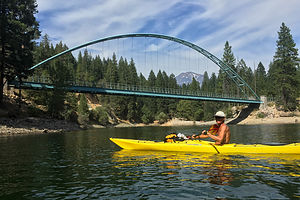 Herb Kayaking in Wagon Creek InletSince the day was still young, we launched our kayaks at the boat ramp, and spent the day paddling around the lake. I couldn’t believe what a difference the lack of snow on Shasta made on the overall experience. It probably would have been better if I didn’t know what I was missing, because then I could have enjoyed the lake and its beautiful surrounds more without lamenting what wasn’t.
Herb Kayaking in Wagon Creek InletSince the day was still young, we launched our kayaks at the boat ramp, and spent the day paddling around the lake. I couldn’t believe what a difference the lack of snow on Shasta made on the overall experience. It probably would have been better if I didn’t know what I was missing, because then I could have enjoyed the lake and its beautiful surrounds more without lamenting what wasn’t.
Going counter-clockwise around the lake, we soon came to the Lake Siskiyou Splash Zone, where there were several large inflatable structures to climb up on and jump from. It looked like a lot of fun. I was tempted to get out of the kayak and play on some, but I hadn’t purchased a ticket, which costs $8 per hour. Also, everyone else playing on them was either under 10 years old or a parent.
Continuing on, at about halfway around the lake, we paddled into Wagon Creek Inlet and passed under the picturesque, green, arched pedestrian bridge, which provides a perfect frame for photos of Mt. Shasta in the background. This is my favorite part of the lake.
After floating and eating lunch, we continued along the northern shore of the lake, stopping once more at an interesting area where the shoreline is studded with stumps that are normally submerged during wetter times.
All in all, the trip around the perimeter of the lake was 5.9 miles and took us a little over 4 hours – and that’s with lots of just lean-back-and-float time included.
Hiking Gray Butte and Exploring Mt. Shasta City
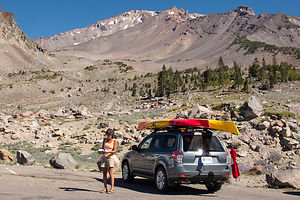 Subaru in Old Ski Bowl parking lotI often consult my Moon California Hiking book when selecting a hike. I like the way they rate hikes on a scale of 1-10 for scenic beauty and 1-5 on difficulty (one being the easiest). The hike to the top of Gray Butte near Mt. Shasta was rated a 10 and 2, respectively – perfect!!
Subaru in Old Ski Bowl parking lotI often consult my Moon California Hiking book when selecting a hike. I like the way they rate hikes on a scale of 1-10 for scenic beauty and 1-5 on difficulty (one being the easiest). The hike to the top of Gray Butte near Mt. Shasta was rated a 10 and 2, respectively – perfect!!
The 14-mile drive along the Everitt Memorial Highway from Mt. Shasta City to the trailhead was a worthwhile activity in itself. We intentionally drove past the Panther Meadow Campground, where the trailhead was, and continued about another mile to the Old Ski Bowl parking lot, the highest point you can drive on Mt. Shasta.
While today, this is the starting point for several hikes, including the one to the summit, it used to be a downhill ski area. Built in 1959, this early day ski resort was pretty ill conceived. Located in a huge open cirque above the tree line at 8,000 feet, it was constantly plagued with avalanches, whiteouts, and road closures. During a 1959 storm that lasted 5 days, it received 16 feet of snow, breaking a Guinness Book of World Records record.
 Lolo with Romantic Art WorkAlthough it was in operation for nearly 20 years, a huge avalanche in 1978, which destroyed its main chair lift, finally resulted in it permanently closing down. Eventually in 1985 a new ski park was built lower down on the mountain in an area below the timberline that was safe from avalanches. Ironically, its problems the last two years have been due to lack of snow.
Lolo with Romantic Art WorkAlthough it was in operation for nearly 20 years, a huge avalanche in 1978, which destroyed its main chair lift, finally resulted in it permanently closing down. Eventually in 1985 a new ski park was built lower down on the mountain in an area below the timberline that was safe from avalanches. Ironically, its problems the last two years have been due to lack of snow.
It was too early for us to utilize one of the picnic tables in the cirque, but we did take time to admire the romantic art work – a heart and “Love” spelt out in large white rocks.
We drove the short distance back to the Gray Butte trailhead in Panther Meadows Campground. From the campground, we passed through lovely Panther Meadow, with Mt. Shasta constantly in our sights, before entering a red fir forest.
At about 0.6 miles, we came to a junction with the Gate Trail, which leads off to the north toward a volcanic valley that some believe to be the mountain’s sacred portal to the spiritual dimension. We decided to skip the spiritual dimension for today and continued south along the more secular Gray Butte trail.
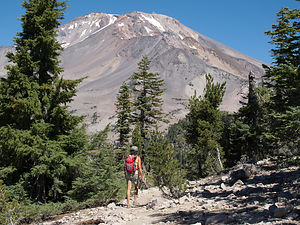 Lolo Hiking up to Gray ButteAs we continued our climb along the eastern side of the butte, the trees changed from red fir to hemlocks. In fact, this area is recognized as one of the best hemlock groves in northern California. About a mile into the hike, we passed through a clearing along the top of a large talus slope falling off to the east, where we could see Red Butte off to the left.
Lolo Hiking up to Gray ButteAs we continued our climb along the eastern side of the butte, the trees changed from red fir to hemlocks. In fact, this area is recognized as one of the best hemlock groves in northern California. About a mile into the hike, we passed through a clearing along the top of a large talus slope falling off to the east, where we could see Red Butte off to the left.
At about 1.2 miles, we made a sharp turn to the right (west) and began hiking along the southern side of Gray Butte. From here, our views were more of the manmade variety as the towers and antennas of the Gray Butte communication facility came into view off to the south.
At 1.6 miles, the trail went right (north), and we climbed along a clearing with stunted hemlocks. Another 0.3 miles and a short scramble over sharp volcanic rock brought us to the 8,119-foot summit of Gray Butte where we were rewarded with tremendous views of Castle Crags, Mount Lassen, and, of course, the ever present Mt. Shasta.
This is an out and back hike, so from there we retraced our steps down to Panther Meadow Campground.
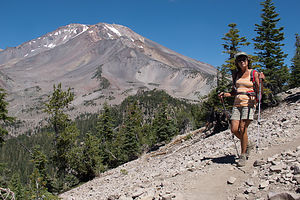 Lolo on Descent from Gray ButteRather than head right back to the campground, we decided to explore Mt. Shasta City for a bit, starting with lunch at the highly Yelp-rated Yaks Cafe. It did not disappoint with its artisan coffees, gourmet burgers, excellent salads and sandwiches, and much more. We had a very delicious salad and coffee.
Lolo on Descent from Gray ButteRather than head right back to the campground, we decided to explore Mt. Shasta City for a bit, starting with lunch at the highly Yelp-rated Yaks Cafe. It did not disappoint with its artisan coffees, gourmet burgers, excellent salads and sandwiches, and much more. We had a very delicious salad and coffee.
Herb wanted to pick up some foam to support the kayaks on the roof rack, so we stopped in a local hardware store. Everyone was so extremely friendly, helpful, and yes, spiritual – something you don’t often find in a hardware store.
As with many other volcanoes, Mount Shasta is considered to be sacred, and spiritual seekers from around the world come here for healing and transcendence. Even customers in the hardware store were talking about their spiritual health. We just needed foam.
Like Sedona, Arizona, Mount Shasta is believed to be the site of a spiritual vortex, an area of high energy concentration originating from magnetic, spiritual, or unknown sources. Vortexes are also thought to be the gateway or portal to other realms, both spiritual and dimensional. If we had made a left rather than a right turn at The Gate trail junction on our hike earlier that day, we could have possibly entered one. We are just too boring and pragmatic to achieve transcendence on a hike.
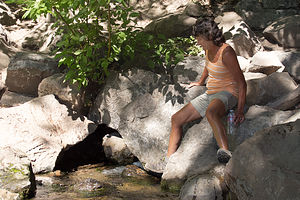 Lolo Approaching Headwaters of the Sacramento RiverWe headed next to Mt. Shasta City Park to search for and drink from the headwaters of the Sacramento River. The search was pretty easy – it was well signed out – but the filling of my water bottle was a bit more of a challenge, as I clambered on rocks and barely avoided falling into the headwaters on my hindquarters.
Lolo Approaching Headwaters of the Sacramento RiverWe headed next to Mt. Shasta City Park to search for and drink from the headwaters of the Sacramento River. The search was pretty easy – it was well signed out – but the filling of my water bottle was a bit more of a challenge, as I clambered on rocks and barely avoided falling into the headwaters on my hindquarters.
On the way back to the campground we made a stop at the Mt. Shasta Sisson Museum, a small, volunteer operated museum dedicated to preserving the history of Mt. Shasta area. It is on the same grounds as the oldest fish hatchery west of the Mississippi. Admission to the museum is free, but a $1 donation is suggested.
We spent a fun half hour exploring the photographs and exhibits explaining the history of the town and the mountain. Our favorite exhibit was one in which you could sit in a simulated train engine and pretend that you are the conductor – fun for kids of all ages.
Back at Lake Siskiyou Camp Resort, we sipped some wine on the beach overlooking the mountain before retiring back to our campsite.
It had been a very full and fun day.
Hiking to Heart Lake and Kayaking around Castle Lake
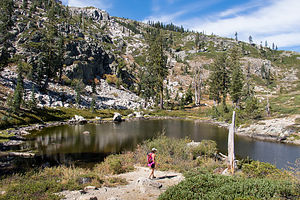 Heart LakeThe girl behind the counter at Yaks Café yesterday had told us that her favorite lake in the area was Castle Lake. She said that it was very beautiful and much more secluded and quiet than Lake Siskiyou – and a great place to launch kayaks.
Heart LakeThe girl behind the counter at Yaks Café yesterday had told us that her favorite lake in the area was Castle Lake. She said that it was very beautiful and much more secluded and quiet than Lake Siskiyou – and a great place to launch kayaks.
It wasn’t very far from our campground – just a mile on the road back towards town, and then 7 miles south on Castle Lake Road.
This was a two activity stop, the first of which would be a 3-mile round-trip hike to even more secluded Heart Lake.
From the parking area, we followed the trail left along the eastern side of the lake. Fairly quickly, the trail veered away from the shoreline and began climbing up the eastern wall above Castle Lake. As we continued to climb, we occasionally caught views of the lake through the trees.
After hiking a little over a mile and making about a 600-foot elevation gain, we came to a saddle and began looking around for the trail. It certainly was not very clearly marked or heavily traveled. Finally, Herb spotted a faint trail to the right. I was not totally convinced, but it was the only game in town, so we followed it up toward a high ridge. Herb was right. Once we reached the top of the ridge, there it was – tiny but lovely Heart Lake right below -- and it really was shaped like a heart.
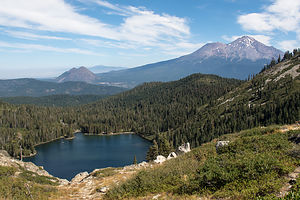 Mt. Shasta with Castle LakeWe walked the short distance down the trail to a rocky outcrop that extended into the lake. In fact, it was this protrusion of rock that gave the lake its heart shape. What a romantic place for lunch. I could practically hear the mushy things Herb was going to say to me over our turkey sandwiches.
Mt. Shasta with Castle LakeWe walked the short distance down the trail to a rocky outcrop that extended into the lake. In fact, it was this protrusion of rock that gave the lake its heart shape. What a romantic place for lunch. I could practically hear the mushy things Herb was going to say to me over our turkey sandwiches.
After lunch, we walked counter-clockwise around the lake and continued west up a rocky trail to a tremendous view of Mt. Shasta with Castle Lake in the foreground below. What a beautiful spot!
The way back was easier to navigate and before long we were back at Castle Lake, where we launched our kayaks at the short, but steep ramp near the parking area.
The lake is stunning – set in a glacial cirque with water as blue as Tahoe’s. Its striking blueness is a result of its pureness and low nitrogen content. UC Davis scientists have been sampling and studying the lake since the 1950s.
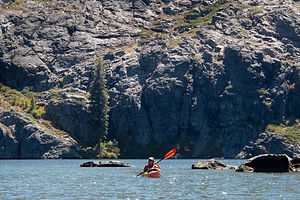 Lolo Kayaking Castle LakeWe started paddling along the western shore to the lake’s most prominent feature -- a high back wall of granite rising from the southwestern shore.
Lolo Kayaking Castle LakeWe started paddling along the western shore to the lake’s most prominent feature -- a high back wall of granite rising from the southwestern shore.
The whole trip around the perimeter of the lake was only 1.3 miles, so after returning to the boat launch, we decided to head back out on the lake. This time I had my eye on the second most prominent feature in the lake – a raft at the southern end, perfect for sunbathing. Unfortunately, a couple had beaten us to it and no amount of casually circling nearby triggered them to give it up. Oh well.
What a great paddle though! I was really enjoying all the opportunities for kayaking in some of the most beautiful lakes in California. We had gotten our kayaks out on the water more this trip than all the other trips combined. What a way to explore a beautiful area!
Sundial Bridge in Redding
 Sundial Bridge and SunOur drive back to our base camp in Petaluma took us south on I5 past the depressingly low waters of drought-ridden Shasta Lake, and near the town of Redding, where we exited to take a brief side trip to see the famous Sundial Bridge.
Sundial Bridge and SunOur drive back to our base camp in Petaluma took us south on I5 past the depressingly low waters of drought-ridden Shasta Lake, and near the town of Redding, where we exited to take a brief side trip to see the famous Sundial Bridge.
This steel, glass, and granite bridge, which was completed in 2004, was designed by the world renowned Spanish architect and engineer Santiago Calatrava. As its name suggests, the bridge is an actual functioning sundial, and one of the largest in the world. However, it is more of a technological marvel and work of art than a replacement for your watch, as its sheer size limits its time keeping abilities. The shadow traces such a large arc that it can only reveal the time between 11 am and 3 pm. Also, in winter the shadow is too far into the nearby arboretum to be seen. When the shadow is visible though, as it was when we were there, you can actually see it move, which it does at the rate of about one foot per minute.
It is definitely worth the stop for anybody passing through Redding.
Description
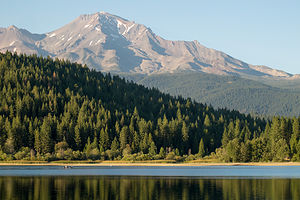 Mt. Shasta with Lake SiskiyouThe Lake Siskiyou Camp Resort is located just 3 miles west of Mount Shasta City, on the lovely shores of glacier-fed, 435-acre Lake Siskiyou. With fantastic views of snow-covered Mount Shasta from its shores, it is one of the prettiest reservoirs in Northern California.
Mt. Shasta with Lake SiskiyouThe Lake Siskiyou Camp Resort is located just 3 miles west of Mount Shasta City, on the lovely shores of glacier-fed, 435-acre Lake Siskiyou. With fantastic views of snow-covered Mount Shasta from its shores, it is one of the prettiest reservoirs in Northern California.
The 7-mile dirt Lake Siskiyou Trail, which encircles the lake, is popular with walkers, joggers, and mountain bikers. The views of Mount Shasta along the way are awesome.
There is a large 150-site, very popular campground for RVs of any length, with full and partial hookups. There are 225 additional sites for tents. There is also a marina, boat rentals (canoes, kayaks, pedal boats, motorized boats), free boat launching, a fishing dock and fish-cleaning station, boat slips, and a swimming beach.
 Lolo in Lake Siskiyou Splash ZoneRecreational opportunities on the lake include:
Lolo in Lake Siskiyou Splash ZoneRecreational opportunities on the lake include:
• swimming
• trout and smallmouth bass fishing
• low-speed boating (boat ramp and boat rentals available)
• hiking the Lake Siskiyou Trail
- ‹ previous
- 5 of 8
- next ›
Lake Siskiyou Camp Resort location map in "high definition"
Javascript is required to view this map.
